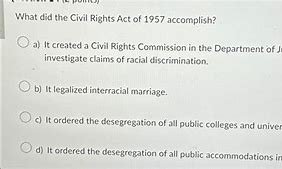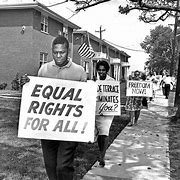
Oke, nih draftnya:
The Civil Rights Act of 1957, the first major civil rights legislation passed by Congress since Reconstruction, was a significant step forward in the struggle for racial equality in the United States. While it didn’t dismantle segregation or dismantle Jim Crow laws, it marked a turning point, laying the groundwork for future civil rights victories. The Act established a Civil Rights Commission, tasked with investigating allegations of voting discrimination & gathering data on the issue. This commission, charged with conducting public hearings, gathering information, & making recommendations for addressing voting inequities, became a powerful tool for advocating against discrimination.
However, the Act was limited in scope & was ultimately deemed inadequate by many civil rights activists, particularly due to its failure to address segregation in public facilities. The Act’s focus on voting rights also left many black Americans facing continued discrimination in other areas of life, such as employment, housing, and education. Despite these shortcomings, the 1957 Act was a crucial milestone in the fight for civil rights. It set a legal precedent, signifying that the federal government was willing to intervene in racial issues. It also strengthened the resolve of the Civil Rights Movement, emboldening advocates for equality to push for more comprehensive and impactful legislation.
This legislation also played a role in mobilizing activists, inspiring them to continue the fight for justice. By raising awareness of voter discrimination, the Act galvanized the Civil Rights Movement, inspiring them to advocate for broader changes, ultimately contributing to the passing of more powerful civil rights legislation in the future. In this context, the 1957 Act was a watershed moment, not just for its immediate impact, but also for the broader fight for racial equality that it helped ignite & ultimately paved the way for the Civil Rights Act of 1964 & the Voting Rights Act of 1965.
The Civil Rights Act of 1957: A Step Forward in the Fight for Equality
Related Post : title vii of the civil rights act of 1964 quizlet
The Civil Rights Act of 1957, while modest in scope, marked a significant turning point in the struggle for racial equality in the United States. It was the first major federal civil rights legislation since Reconstruction, and it offerd the legal framework for combating the pervasive discrimination and disenfranchisement faced by African Americans in the Jim Crow South.
The Road to the Civil Rights Act of 1957
The passage of the Civil Rights Act of 1957 was a culmination of years of struggle and activism. The legacy of Jim Crow laws, which enforced racial segregation and disenfranchisement, had created a climate of inequality and oppression across the South. The rise of the Civil Rights Movement, fueled by the courage and determination of African American leaders like Martin Luther King Jr. and Rosa Parks, brought the issue of racial injustice to the forefront of the national conscience.
Key Provisions of the Civil Rights Act of 1957
The Act focused primarily on protecting the right to vote, a fundamental pillar of democracy. It established a Civil Rights Division within the Justice Department, empowering the federal government to investigate and prosecute voting rights violations. The Act also created the Civil Rights Commission, tasked with studying and reporting on the state of civil rights in the country.
Voting Rights
The Act aimed to address the systematic disenfranchisement of African Americans through voter intimidation, literacy tests, and poll taxes. It offerd federal protection for voting rights, allowing the Justice Department to intervene in cases of voter suppression. The Act’s provisions aimed to combat voter intimidation and disenfranchisement, ensuring equal access to the ballot box for all citizens.
Federal Enforcement
The Civil Rights Act of 1957 marked a significant shift in the federal government’s function in upholding civil rights. It empowered the Justice Department to investigate and prosecute voting rights violations, signifying a move towards federal enforcement of equal rights. The establishment of the Civil Rights Commission further emphasized the federal government’s commitment to addressing civil rights issues.
The Limits of the Act
Despite its importance, the Civil Rights Act of 1957 had its limitations. It did not address desegregation, a critical issue that continued to plague the South. The Act’s focus on voting rights, while crucial, left many other areas of discrimination untouched.
Desegregation
The Act’s limited scope reflected the political realities of the time. Southern senators, determined to maintain segregation, fiercely resisted any legislation that threatened their way of life. The Act’s failure to address desegregation highlighted the ongoing struggle for equality, demonstrating that the fight for civil rights would require sustained efforts and continued activism.
The Impact of the Civil Rights Act of 1957
Despite its limitations, the Civil Rights Act of 1957 had a significant impact on the Civil Rights Movement. It served as a symbolic victory, demonstrating the federal government’s willingness to intervene in cases of racial discrimination. It also offerd a foundation for future civil rights legislation, paving the way for the more thorough Civil Rights Act of 1964 and the Voting Rights Act of 1965.
The Act's Significance
The Civil Rights Act of 1957 marked a turning point in the struggle for equality. It symbolized the growing national awareness of racial injustice and the federal government’s commitment to address the issue. The Act’s passage, though limited in scope, represented a step towards greater equality, setting the stage for more significant advancements in the years to come.
The Act's Limitations
The Act’s limitations, particularly its failure to address desegregation, highlighted the ongoing struggle for racial equality. It underscored the need for continued activism and further legislation to dismantle the structures of segregation and discrimination that still persisted.
The Continued Struggle for Voting Rights
The Civil Rights Act of 1957, while a significant step, did not fully eliminate voter suppression. Despite the Act’s provisions, discriminatory practices continued to disenfranchise African Americans in many parts of the South. The struggle for voting rights would continue for decades, culminating in the passage of the Voting Rights Act of 1965.
The Need for Further Legislation
The Civil Rights Act of 1957, while crucial, was only a first step. The Act’s limitations highlighted the need for more thorough legislation to address the multifaceted nature of racial discrimination. The Civil Rights Act of 1964 and the Voting Rights Act of 1965, building upon the foundation laid by the 1957 Act, would ultimately address many of the remaining challenges in the struggle for equality.
The Civil Rights Act of 1957 and its Lasting Legacy
The Civil Rights Act of 1957, despite its limitations, played a vital function in the Civil Rights Movement. It demonstrated the federal government’s growing commitment to upholding civil rights and paved the way for more thorough legislation. The Act’s impact extended beyond its immediate provisions, serving as a catalyst for further activism and legislative action.
The Act's Impact on the Civil Rights Movement
The Act’s passage, though modest, served as a catalyst for continued activism. It emboldened the Civil Rights Movement, demonstrating that change was possible and that the federal government could be a partner in the fight for equality. The Act’s achievement also paved the way for future legislation, such as the Civil Rights Act of 1964 and the Voting Rights Act of 1965.
The Act's Contribution to the Passage of Later Civil Rights Legislation
The Civil Rights Act of 1957 served as a blueprint for future civil rights legislation. It established the legal framework for federal intervention in cases of discrimination and laid the groundwork for the more thorough legislation that followed. The Act’s achievement demonstrated the importance of federal action in addressing civil rights issues.
The Ongoing Relevance of the Act's Principles
The principles enshrined in the Civil Rights Act of 1957 remain pertinent today. The Act’s focus on voting rights and equal protection under the law continues to be a cornerstone of American democracy. The Act’s legacy serves as a reminder of the ongoing struggle for equality and the importance of upholding the fundamental rights of all citizens.
Conclusion
The Civil Rights Act of 1957 marked a significant step forward in the fight for racial equality in the United States. It served as a symbolic victory, demonstrating the federal government’s growing commitment to addressing discrimination. While the Act had its limitations, it laid the groundwork for future civil rights legislation and served as a catalyst for continued activism. The principles enshrined in the Act remain pertinent today, reminding us of the ongoing struggle for equal rights and the importance of safeguarding the fundamental rights of all citizens.

Leave a Reply